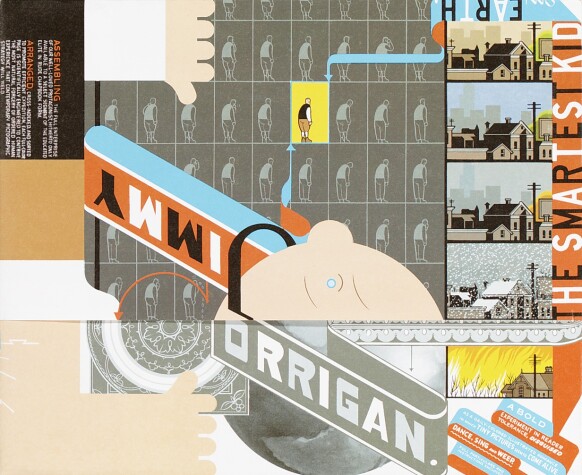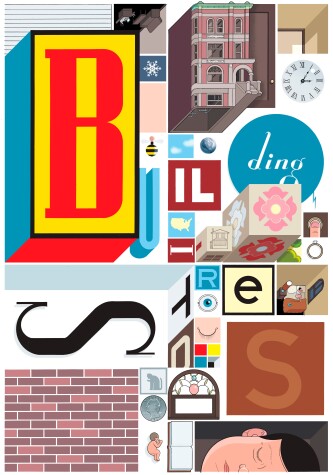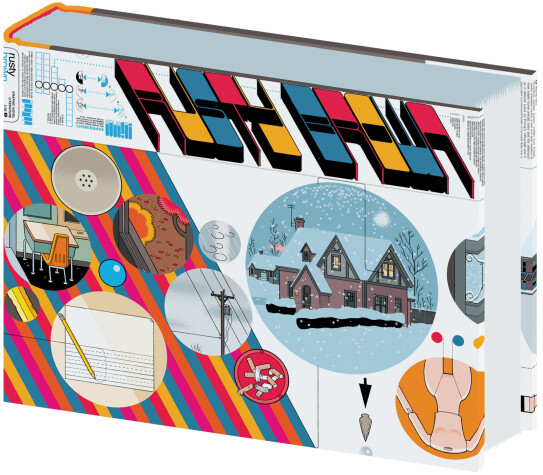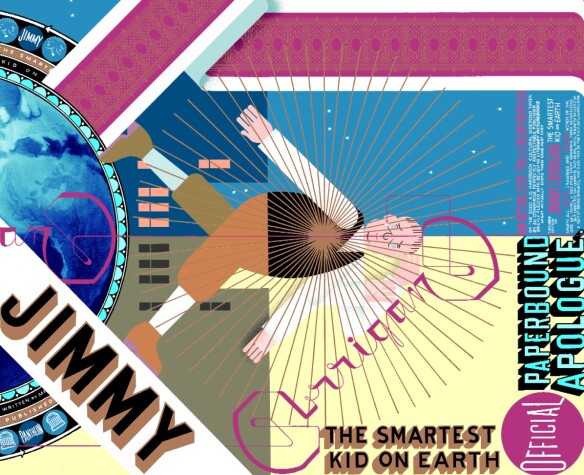Pantheon Graphic Library
5 total works
Utterly eschewing the general bonhomie surrounding the newly-minted contemporary regard for the comic strip medium as a language of complicated personal expression and artistic sophistication, professional colorist and award-winning letterer F. C. Ware returns to the book trade with “The ACME Novelty Library,” a hardcover distillation of all his surviving one-page cartoon jokes with which he tuckpointed the holes of his regular comic book periodical over the past decade.
Sometimes claimed to be his “best work” by those who really don’t know any better, this definitive congestion of stories of the future, the old west, and even of modern life nonetheless tries to stay interesting by including a luminescent map of the heavens, a chart of the general structure of the universe, assorted cut-out activitites, and a complete history of The ACME Novelty Company itself, decorated by rare photographs, early business ventures, not to mention the smallest example of a Comic Strip ever before offered to the general public. All in all, it will likely prove a rather mild disappointment, but at least it catches the light in a nice way and may force a smile here and there before being shelved for the next generation’s ultimate disregard and/or disposal.
Sometimes claimed to be his “best work” by those who really don’t know any better, this definitive congestion of stories of the future, the old west, and even of modern life nonetheless tries to stay interesting by including a luminescent map of the heavens, a chart of the general structure of the universe, assorted cut-out activitites, and a complete history of The ACME Novelty Company itself, decorated by rare photographs, early business ventures, not to mention the smallest example of a Comic Strip ever before offered to the general public. All in all, it will likely prove a rather mild disappointment, but at least it catches the light in a nice way and may force a smile here and there before being shelved for the next generation’s ultimate disregard and/or disposal.
The first book from the Chicago author of the “stunning” Building Stories (The New York Times) is a pleasantly-decorated view at a lonely and emotionally impaired "everyman," who is provided, at age 36, the opportunity to meet his father for the first time.
“This haunting and unshakable book will change the way you look at your world.” —Time magazine
“There’s no writer alive whose work I love more than Chris Ware.” —Zadie Smith, New York Times bestselling author of Swing Time
An improvisatory romance which gingerly deports itself between 1890's Chicago and 1980's small town Michigan, the reader is helped along by thousands of colored illustrations and diagrams, which, when read rapidly in sequence, provide a convincing illusion of life and movement. The bulk of the work is supported by fold-out instructions, an index, paper cut-outs, and a brief apology, all of which concrete to form a rich portrait of a man stunted by a paralyzing fear of being disliked.
“This haunting and unshakable book will change the way you look at your world.” —Time magazine
“There’s no writer alive whose work I love more than Chris Ware.” —Zadie Smith, New York Times bestselling author of Swing Time
An improvisatory romance which gingerly deports itself between 1890's Chicago and 1980's small town Michigan, the reader is helped along by thousands of colored illustrations and diagrams, which, when read rapidly in sequence, provide a convincing illusion of life and movement. The bulk of the work is supported by fold-out instructions, an index, paper cut-outs, and a brief apology, all of which concrete to form a rich portrait of a man stunted by a paralyzing fear of being disliked.
From the author of Jimmy Corrigan: The Smartest Kid on Earth comes one of the most acclaimed graphic novels of all time: 14 distinctively discrete Books, Booklets, Magazines, Newspapers, and Pamphlets. • “One of the most important pieces of art I have ever experienced.” —The New Republic
With the increasing electronic incorporeality of existence, sometimes it’s reassuring—perhaps even necessary—to have something to hold on to. Thus within this colorful keepsake box the purchaser will find a fully-apportioned variety of reading material ready to address virtually any imaginable artistic or poetic taste, from the corrosive sarcasm of youth to the sickening earnestness of maturity—while discovering a protagonist wondering if she’ll ever move from the rented close quarters of lonely young adulthood to the mortgaged expanse of love and marriage. Whether you’re feeling alone by yourself or alone with someone else, this book is sure to sympathize with the crushing sense of life wasted, opportunities missed and creative dreams dashed which afflict the middle- and upper-class literary public (and which can return to them in somewhat damaged form during REM sleep).
A pictographic listing of all 14 items (260 pages total) appears on the back, with suggestions made as to appropriate places to set down, forget or completely lose any number of its contents within the walls of an average well-appointed home. As seen in the pages of The New Yorker, The New York Times and McSweeney’s Quarterly Concern, Building Stories collects a decade’s worth of work, with dozens of “never-before-published” pages (i.e., those deemed too obtuse, filthy or just plain incoherent to offer to a respectable periodical).
With the increasing electronic incorporeality of existence, sometimes it’s reassuring—perhaps even necessary—to have something to hold on to. Thus within this colorful keepsake box the purchaser will find a fully-apportioned variety of reading material ready to address virtually any imaginable artistic or poetic taste, from the corrosive sarcasm of youth to the sickening earnestness of maturity—while discovering a protagonist wondering if she’ll ever move from the rented close quarters of lonely young adulthood to the mortgaged expanse of love and marriage. Whether you’re feeling alone by yourself or alone with someone else, this book is sure to sympathize with the crushing sense of life wasted, opportunities missed and creative dreams dashed which afflict the middle- and upper-class literary public (and which can return to them in somewhat damaged form during REM sleep).
A pictographic listing of all 14 items (260 pages total) appears on the back, with suggestions made as to appropriate places to set down, forget or completely lose any number of its contents within the walls of an average well-appointed home. As seen in the pages of The New Yorker, The New York Times and McSweeney’s Quarterly Concern, Building Stories collects a decade’s worth of work, with dozens of “never-before-published” pages (i.e., those deemed too obtuse, filthy or just plain incoherent to offer to a respectable periodical).
A major graphic novel event more than 18 years in progress: part one of the ongoing bifurcated masterwork from the brilliant and beloved author of Jimmy Corrigan: The Smartest Kid on Earth and Building Stories.
Rusty Brown is a fully interactive, full-color articulation of the time-space interrelationships of three complete consciousnesses in the first half of a single midwestern American day and the tiny piece of human grit about which they involuntarily orbit. A sprawling, special snowflake accumulation of the biggest themes and the smallest moments of life, Rusty Brown literately and literally aims at nothing less than the coalescence of one half of all of existence into a single museum-quality picture story, expertly arranged to present the most convincingly ineffable and empathetic illusion of experience for both life-curious readers and traditional fans of standard reality. From childhood to old age, no frozen plotline is left unthawed in the entangled stories of a child who awakens without superpowers, a teen who matures into a paternal despot, a father who stores his emotional regrets on the surface of Mars and a late-middle-aged woman who seeks the love of only one other person on planet Earth.
Rusty Brown is a fully interactive, full-color articulation of the time-space interrelationships of three complete consciousnesses in the first half of a single midwestern American day and the tiny piece of human grit about which they involuntarily orbit. A sprawling, special snowflake accumulation of the biggest themes and the smallest moments of life, Rusty Brown literately and literally aims at nothing less than the coalescence of one half of all of existence into a single museum-quality picture story, expertly arranged to present the most convincingly ineffable and empathetic illusion of experience for both life-curious readers and traditional fans of standard reality. From childhood to old age, no frozen plotline is left unthawed in the entangled stories of a child who awakens without superpowers, a teen who matures into a paternal despot, a father who stores his emotional regrets on the surface of Mars and a late-middle-aged woman who seeks the love of only one other person on planet Earth.
The first book from the Chicago author of the “stunning” Building Stories (The New York Times) is a pleasantly-decorated view at a lonely and emotionally impaired "everyman," who is provided, at age 36, the opportunity to meet his father for the first time.
“This haunting and unshakable book will change the way you look at your world.” —Time magazine
“There’s no writer alive whose work I love more than Chris Ware.” —Zadie Smith, New York Times bestselling author of Swing Time
An improvisatory romance which gingerly deports itself between 1890's Chicago and 1980's small town Michigan, the reader is helped along by thousands of colored illustrations and diagrams, which, when read rapidly in sequence, provide a convincing illusion of life and movement. The bulk of the work is supported by fold-out instructions, an index, paper cut-outs, and a brief apology, all of which concrete to form a rich portrait of a man stunted by a paralyzing fear of being disliked.
“This haunting and unshakable book will change the way you look at your world.” —Time magazine
“There’s no writer alive whose work I love more than Chris Ware.” —Zadie Smith, New York Times bestselling author of Swing Time
An improvisatory romance which gingerly deports itself between 1890's Chicago and 1980's small town Michigan, the reader is helped along by thousands of colored illustrations and diagrams, which, when read rapidly in sequence, provide a convincing illusion of life and movement. The bulk of the work is supported by fold-out instructions, an index, paper cut-outs, and a brief apology, all of which concrete to form a rich portrait of a man stunted by a paralyzing fear of being disliked.




